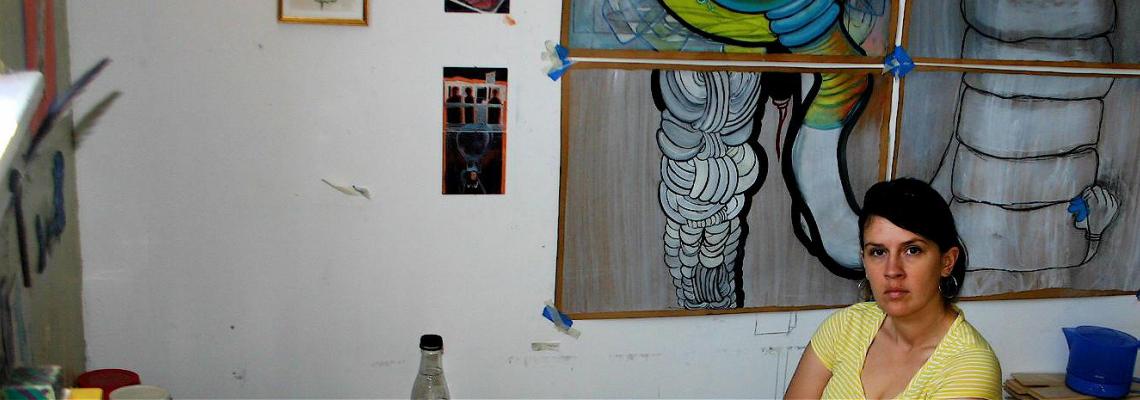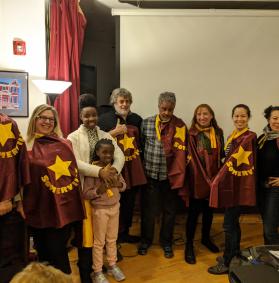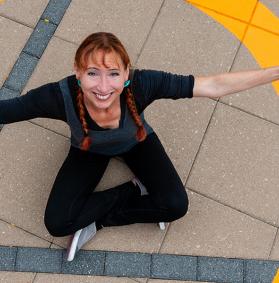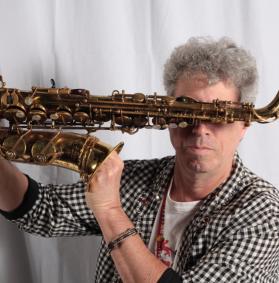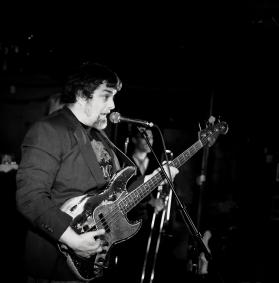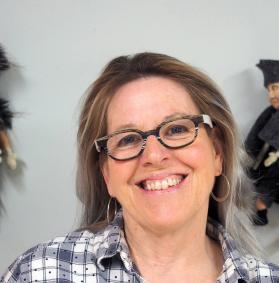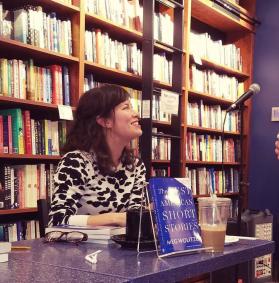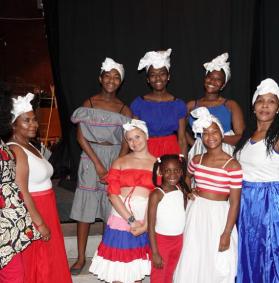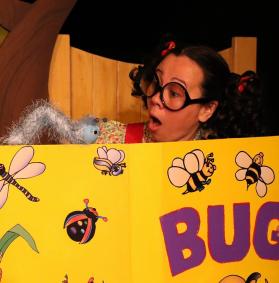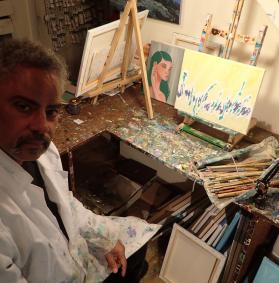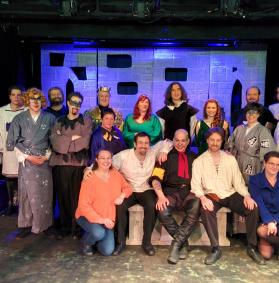Interview with Maria as told to Kerrie Kemperman
How long have you been painting and what drew you to the medium?
Like a lot of artists, I started drawing as a kid, and then I suppose it eventually became about being recognized, and put into certain art classes, or invited to do things. So painting came in during high school actually, in AP art. My first paintings were in portraiture, still lives, etc. Then I went on to the Maryland Institute, College of Art which had a very foundational, traditionally academic way of bringing students through painting, drawing, sculpture—being well versed.
I have always made economical choices in terms of materials. I am committed to using materials and techniques a little bit more purposefully. I’ve always had some sort of illustrative aspect, which came out of drawing, as well as a storytelling component, so all of this together is what drew me to painting, I suppose. As a young student at MICA, I was also drawn to the actual fluidity of paint, the ability to mix various oils and varnishes, the preparation of it; then it became about choosing ingredients, the tools, the smells. All of it captivated me right away & became my familiar terrain, and so I keep choosing it.

 Are you currently working in other media as well – and if so, which ones?
Are you currently working in other media as well – and if so, which ones?
Yes, I do work and teach in a lot of other media. I work a lot in papier-maché in the studio. I also studied film and other media; motion graphics, kinetics, and coding for interactive art, when I went to the School of the Art Institute of Chicago. I started making handmade films. I would create and color them by hand with dyeing, scratching, etc. I have been unearthing those films again, as I start to do more animation and incorporate some of those techniques I used to use.
What are your favorite materials or the themes that find their way into your work?
Twenty-two years ago I lived off of lower Broadway toward Sullivan Sq. here in Somerville, and I definitely couldn’t afford to have a separate studio. I had previously been painting large-scale  oil paintings, while in art school. So essentially I was forced by circumstance to work smaller, with gouache and other water-based paints at home, as I didn’t want to use any oils or solvents at home. This still informs my work to some degree as I tend to paint in a larger format with oils and more intimately with water-based media, though this is changing these days as I’ve made some larger acrylic-based works.
oil paintings, while in art school. So essentially I was forced by circumstance to work smaller, with gouache and other water-based paints at home, as I didn’t want to use any oils or solvents at home. This still informs my work to some degree as I tend to paint in a larger format with oils and more intimately with water-based media, though this is changing these days as I’ve made some larger acrylic-based works.
Back then I started to make these papier-maché dolls with my toddler daughter and while she slept, I would paint them meticulously with gouache and acrylics. The dolls were of mothers, women, women holding babies, or couples sitting, somewhat whimsical sculpted and painted portraits of friends. I would give them away as wedding presents, etc. I have a few left around my house.
I pretty much paint on any surface, which came out of not having any real budget for art-making. If you need to make art, but you don't have a lot of money, you’ll paint on anything. I fished an old abandoned boat out of the water last year, which is not an unusual feat for me. One of my paintings is on wood salvaged from a table top.
There is no doubt my work is autobiographical. Intellectual interests, life experience, paying attention, all of it finds a way into the work. It gets integrated throughout the process. I suppose I am of the school that thinks of ourselves as more of a conduit of sorts. I’ll let someone else gather information from my work, or have a conversation about it certainly, but my art is a distillation or process of my own experience, so I think that’s enough in terms of a larger explanation of why or how, etc. I’m working as much as I can, and learning and listening to myself and my process.
What keeps you creating new work?
 The need. Making art is a way of processing the world. What I’ve come to find out through my counseling work is what a blessing—or luxury rather—it is to be an artist. To have skills and be dexterous with materials, sure, but also to have this template to work within. It’s always something that I’ve had, and so in some sense it gets taken for granted, right? Working with folks who have had no exposure to art nor to materials, I notice that art-making provides time for reflection, for processing, for experimentation, essentially, for play.
The need. Making art is a way of processing the world. What I’ve come to find out through my counseling work is what a blessing—or luxury rather—it is to be an artist. To have skills and be dexterous with materials, sure, but also to have this template to work within. It’s always something that I’ve had, and so in some sense it gets taken for granted, right? Working with folks who have had no exposure to art nor to materials, I notice that art-making provides time for reflection, for processing, for experimentation, essentially, for play.
I used to think it sounded corny, and to the greater art community in general I think it does, but art-making provides a certain type of mindfulness. I think we’re also finally realizing that this is okay. We really all need to be practicing self-care, and taking care of one another. Making art helps tremendously with anyone seeking to know themselves or their process and the integration of their experiences, a bit better. Never mind having it around to take in, or experience, etc. We have those statistics. Making art allows the artist to work through problems, sit with things, be in a “flow” state with the process. These are abilities, sure, but they are also major assets to this human experience. These are what compel me to keep creating, and sharing my work with other people. This is also what and why I teach, both in schools and in hospitals, as well as a large part of what gets incorporated into the clinical work I do.
What excites or challenges you?
Materials. Traveling. Culture. Meeting people who I feel a kinship to, who are full of life and kindness, who think for themselves, who are authentic and grounded, or on a path. Discovering a sense of play is important in keeping inspiration afloat: taking risks, or tooling around with new ideas, new terrain, diving deeper, new materials. My own story continues to challenge me. Staying true to my own process in the studio and also earning a living is a challenge.
Working in the studio was a challenge for many years, as a single mom. Now, my daughter is an adult and I have ample time in the studio, but it certainly was not easy for me to try and work while parenting alone, and having a full-time job or being an adjunct at several different schools.
You know, I talk a lot about all of these gifts and authenticity, the process of creativity and how that is a huge part of my pedagogy in teaching and in counseling work, but the flip side is that it’s not so easy to be an artist. Making yourself vulnerable, putting yourself out there again and again, especially when you can’t make it your priority as a parent, is difficult. If you’re not painting you aren’t doing your work, but what if I wasn’t parenting? Early on I had to make a decision; the work would always be there, but my daughter would not always be small. Without unlimited time, I couldn’t be 100% behind my work, so I showed work maybe once or twice a year while she was growing up. It was more important to me to show up for her, after realizing my initial crisis of I can’t do both at full capacity. It’s hard to go to the studio if Grandma is coming over for three hours or overnight and you have to say to yourself, ok, you have to be inspired now, leave in 10 minutes and you can work for 90 minutes. Well, by the time you get to the studio and make coffee and set up, you have to go. It was never a lifestyle that I could merge very well with parenting, but I always kept a studio and worked when I could. These were real challenges, and I think they are overlooked because many artists who have partners are able to do the work, they share the load. Or maybe they started their careers first, then chose to have children. I didn’t really find myself in that situation, and those are my issues, but that is where I am at. I had my daughter before I finished my BFA, so I never really got started in the professional world until after she was born and it’s been a very slow haul. Though I used to trek her around everywhere; I was always at shows, and trying to support the other artists that I hung around with, or went to school with. Now, they are all having kids—haha—so it’s kind of a bizarre place I am in that I don’t personally know of many others in that same boat, who came along with me from school or whatever, and so that can also be challenging.


Tell us a bit about your background, your connection or choice to live/work in Somerville.
So I am from Greater Boston, I always say. I kind of grew up all over the place, but essentially never too far from here. My father was born here in Somerville, my mother in Cambridge, and so a lot of my family, well, built a lot of the area! I’m kind of joking, but actually, a lot of the men and women I grew up around, including my uncles, aunts, and cousins, include workers who came home from the service and were steel workers, pile drivers and divers, building docks all along the New England coast, buildings, working on major construction projects, foremen and union guys, builders. The women were shopkeepers, factory workers, secretaries, homemakers, artists. I have a lot of deep roots in labor on both sides of my family here. We also have lawyers and bankers in there, and mom & pop style restaurants. One of my grandfathers was a Navy ship captain, whose retirement project was having a passenger ferry to take people from Boston to Provincetown. So I always grew up being on, near, or in the water & learning about the sea—which has come up in my work especially when I was living in land-locked places and missing the ocean. My daughter was also born in the area, as we were living in Somerville at the time. I moved around a bit in between then and now, but I’ve returned first and foremost because my studio has been here at Vernon Street for about a while now, and it’s a great building. I was also doing a Master’s degree nearby in Cambridge, so it wasn’t really much of a decision to come and live here again, it just made sense. Basically, I love traveling and going to a million different places, but this is definitely home to me.
What are your thoughts on the local creative scene?
Well, it’s definitely more costly—I mean, let’s all admit it—to live around here, so I’m almost too busy just keeping up. Head down, working. I feel like there is no way not to open up a can of worms with this question. I do feel like more art, more creativity, is always good. I’m also very responsive to this climate of self-care around Somerville/Cambridge—I like that it has become hip to take care of ourselves and each other, finally. I would be remiss if I did not acknowledge that we have opportunity here. Simultaneously, there is also a part of me that feels like there’s a big shift in things becoming about commodity. That is the part that I am partially in conflict with—because of course it’s good to sell, to make a living as a maker, and yet it’s an ambiguous territory for me in terms of what category things fall into. Not because I want to categorize, but because as humans we are compelled to this type of behavior; so it can become a little bit inundating I guess is what I am saying. The amount of shops, new items, and things that have the handmade label—who are these items for? I think it’s easy to both take the gourmet and elite lifestyle for granted here as a resident, and be easily overwhelmed, question everything and the balance it’s keeping or skewing. It’s like, which day do I acknowledge the amount of privilege I have and which day do I bask in its glory? I feel like I’m consumed by the but is it art, or is it necessary question all of the time, and I’m consumed by thinking about the cost of living all of the time, so that kind of gets in the way of always staying positive about a “creative economy”. I do always try and move around that though, and just keep focused on making connections with places and people—but it’s also hard not to think critically, as I was trained to do. I also don’t think the costs of living, the products, and the upscale quality everything has, is honestly for everyone. So that bothers me. We are a little bit of an extension of Brooklyn here, which is kind of a curse/blessing. It’s confusing. I left for a long time and I was raising my daughter, so I’m still acclimating to these changes and am somewhat consumed by what is next for me and what can I afford. At the same time, I do have to shout out that the city itself, having people who dedicate themselves to helping sustain practicing artists, like Somerville Arts Council and Somerville Open Studios, is really a bonus. There is a tremendous amount of work that people do to help support the arts, and I am grateful for it. I also appreciate that we have opportunity, period—and I am thankful.
What do you do for a living and how does it influence your art (or vice versa)?
I am a counselor—(mental health clinician). I also work as a teacher a good part of the year, and do odd jobs and hustle like most artists always have, because these things alone, unfortunately, do not pay the bills. Of course my work is always for sale, and I have also worked in local restaurants, farms, as in-home care for elders, and for little ones as well. All of this influences my work in so far as I have seen many faces of the human experience, I have assisted people in birth, in death, in conflict, in crisis, in addiction, in recovery, and all of these processes teach me. I don’t label that my work is directly about any of this, necessarily, though occasionally it is, of course. Again, it’s about process. After my own mother passed I did a series of three paintings over the period of a year. It was about my own process in grief.
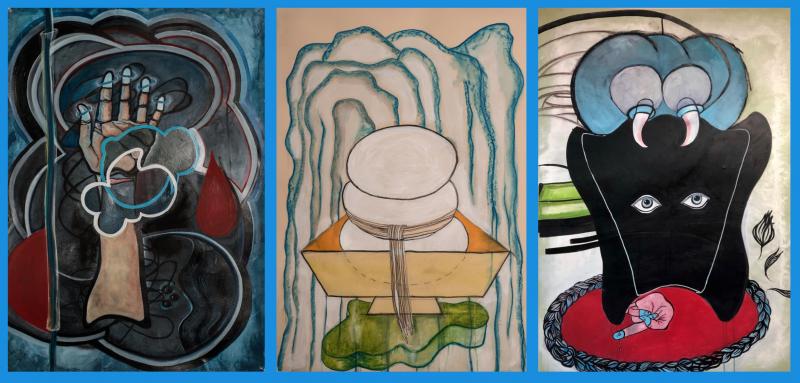
Right now, I am actually doing a series called “chefs and others” that I started several years ago but just picked up again, of friends who work in or around the food industry—chefs, cooks, servers, musicians who play gigs in restaurants, sign painters—so another direct link to my immediate lived experience. It’s helping me to capture a moment in time in the area. It’s also about finding a sense of community in the chaos that has expelled many an artist friend from the Boston area due to the cost of living. It’s like taking stock of who is here now, capturing them in some way, and having a record of it. This is my way of searching for community, and finding a common thread. Just by sheer luck I know a lot of people who work in or around this field so I thought it would be fun to tie in what I do with a portrait series of a select bunch, which may find itself into a show later this year at the PRX offices in Allston.
What artists, writers, musicians inspire you and your work?
Magical realism influences me just as much as CNN or walking down the street and watching a guy feed the birds a piece of toast. In recent years I have read way too much non-fiction for grad school about the complexities of psychology, neuroscience, and counseling with compassion. I do always keep poetry around to keep things in balance. I have always loved Patti Smith’s writing, Jane Kenyon… other books on the desk are by Helen Czerski, Carolyn Steel, Barbara Ehrenreich.
In terms of other artists, I’ve always praised Ray Yoshida, one of my beloved teachers at SAIC who passed away. He would tell me, “stop putting heavy black lines around everything!” The next time I saw him I told him I tried and I couldn’t. “Ok. I just wanted to see if you needed to do it.” Then he started calling me “Lasso LaCreta” because back then I painted everything with a sort of dark lasso-shape around it. I also had a teacher named Michiko Itatani, another painter, and she said to me very early on, after I had a bad crit with a visiting artist, where the only thing he liked was something that was akin to his own work. “..what does he know? I mean really, I went to school with him, who is he? He’s my peer, and I’m telling you to keep going. I am not interested in how your work might look or resemble anything I myself do, I am interested in how it is different and in what you are thinking about when you do it.” So these are the people who influenced me, and gave me a foundation. Michiko and Ray, Gaylen Gerber, Susanne Doremus, Ken Tisa, Patrice Sullivan, Ted Halkin, Phil Hanson, and basically all of my teachers. They were the ones that said just work. Read Art Forum, Art News, all of the art magazines, go out looking, and be responsible for what is out there—look at it, but do your own thing.
Other direct inspiration is folkloric or traditional arts like Latin American retablos and Indian deity pieces, altars, statues, Indonesian shadow puppets, ornate jewelry, prayer pieces, ceremonial objects—these excite me, because they are real, colorful, and resourceful. Chefs, cooking, traditional foods is a huge part of my life and my family life, and that is exciting too, which is why I am doing that current project with ‘chefs and others’ I suppose. Work about women’s lives, especially when it comes to the complexities of bringing up children as a single mother, excites me. I probably like all of that as much as any paintings by people I’ve always looked to and admired, like Larri Pittman, Jane Hammond, Karl Wirsum,—all of the Hairy Who people, many of whom were also students of Ray’s in the generation ahead of me.
I do tend to jam out in the studio to a large range of tunes. I listen to Monk, Method Man, Joanna Newsom, José James, Frank Ocean, Leonard Cohen, BADBADNOTGOOD, disco, house, jazz—it depends on my mood! Whatever medium I’m working with, whatever vibe or pace of working I’m trying to match dictates this. I grew up with tons of music, and my house was always full of musicians, even now, so it’s very important to me and influential in terms of getting things going.
What are your favorite Somerville places/spaces?
I like Celeste—I was just there with some friends visiting from Puerto Rico, and it was fantastic! I have been going to Highland Kitchen forever, and now live very close by, and so I like them a lot. I love the breakfast sandwiches at Hot Box—delicious. I’ve been a fan for more than twenty years of Somerville’s Market Basket and Reliable Market—so let’s shout them out, because I am so happy they are both still in existence, and I hope they have those spaces forever. I also go to Mamma Lisa’s pizza when I want a slice. The food at La Posada and Rincón Mexicano, and Sam’s Falafel—I crave that toum sauce on the regular, and the desserts are delicious.
Is there anything else you wish I'd asked?
This has been an interesting exercise thanks for thinking of me! There are many bigger issues that intrigue me in terms of what the political climate is, how the world seems to be ending for democrats, how there is little to no affordable housing for artists (or anyone that is lower-income), and also how there are no galleries in Somerville! But, well, you can’t have everything. I am open to having studio visits to show existing work, to talk about commissions, murals, etc.—so please get in touch, or come by to my open studios May 4/5. I’d love to see you!
Maria’s Instagram: marialacreta and website: www.marialacreta.com
